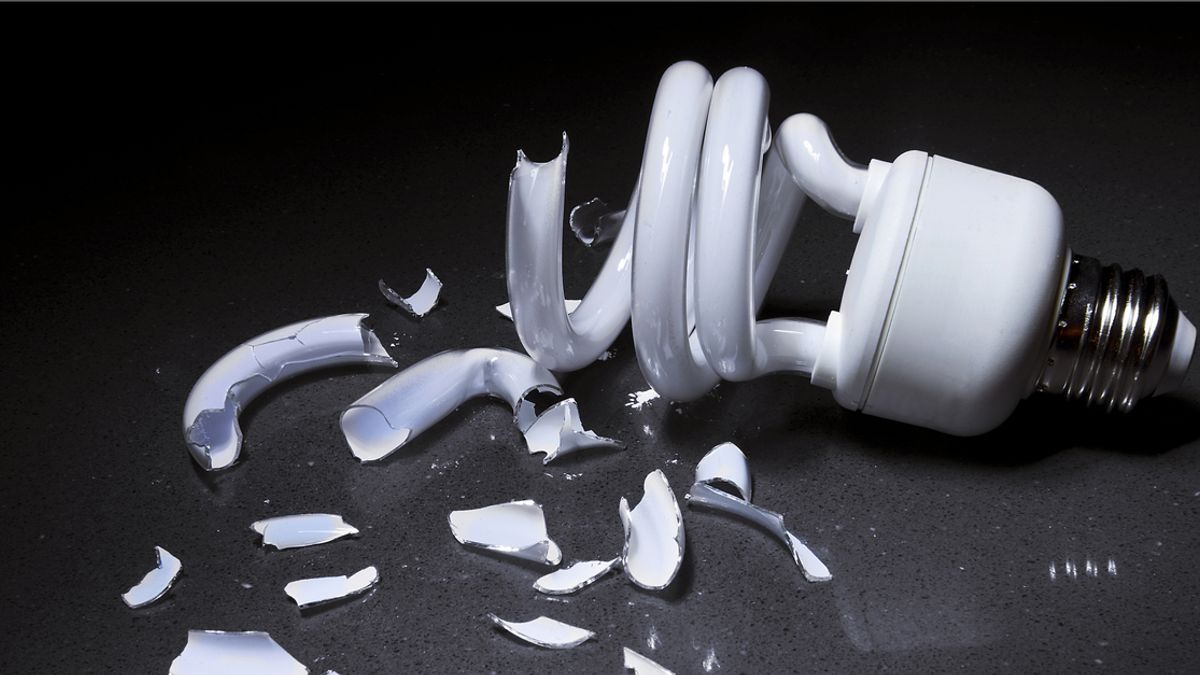Compact fluorescent bulbs (CFLs) contain a small amount of mercury, which is released when the bulb breaks. While CFLs are more energy-efficient than traditional incandescent bulbs, they should be disposed of properly to avoid environmental contamination.
Most of us have switched to compact fluorescent bulbs (CFLs) to save energy, but there are some health concerns about these bulbs. Some people worry that the mercury in CFLs is dangerous, but according to the EPA, it’s actually not a big risk. Here’s what you need to know about CFLs and mercury:
Mercury is a naturally occurring element that is found in small amounts in the environment. It is also an ingredient in many products we use every day, including thermometers, dental fillings and certain types of light bulbs.
Compact fluorescent bulbs contain a very small amount of mercury sealed inside the glass tubing – an average of 4 milligrams per bulb.
By comparison, older style fluorescents can contain 50-100 times more mercury than CFLs.
The amount of mercury released from a broken CFL is very small and poses little health risk. However, it’s important to clean up any broken glass and dispose of the bulb properly.

Credit: www.snopes.com
Which is More Harmful Led Or Cfl?
LEDs and CFLs are both types of energy-efficient lighting. LEDs use less energy than CFLs, but they cost more upfront. However, LEDs last longer than CFLs, so they eventually end up being cheaper in the long run.
Both LEDs and CFLs contain mercury, so it’s important to dispose of them properly.
Are Cfl Bulbs Hazardous?
Most people are familiar with CFL bulbs, or Compact Fluorescent Lights. These are the long, spiral shaped bulbs that have become increasingly popular in recent years as a more energy efficient alternative to traditional incandescent light bulbs. But there is some concern that these CFL bulbs may be hazardous to our health.
So, are CFL bulbs hazardous? The short answer is no, they are not. While it is true that CFL bulbs do contain a very small amount of mercury (which is what makes them so energy efficient), this mercury is sealed inside the glass tube of the bulb and poses no threat to human health unless the bulb is broken.
In fact, according to the EPA, a standard 40 watt CFL bulb contains about 4 milligrams of mercury – which is about 1/100th of the amount of mercury in a standard household thermometer!
However, if a CFL bulb does break in your home, it is important to take precautions to clean up the spill and ventilate the area well. You can find more information on how to do this on the EPA website (www.epa.gov/cfl).
So while CFLs are not dangerous themselves, it’s always important to follow safety guidelines when handling any type of lightbulb!
Do Cfl Bulbs Emit Radiation?
CFL bulbs are more energy-efficient than traditional incandescent bulbs, but some people worry about whether they emit radiation. Here’s what you need to know.
CFL bulbs do emit radiation, but it’s not the kind that is harmful to humans.
The radiation emitted by CFL bulbs is in the form of ultraviolet (UV) light, which is invisible to our eyes. Although UV light can be harmful if we’re exposed to too much of it, the amount emitted by CFL bulbs is very low and poses no known health risk.
Is It Ok to Touch Fluorescent Bulbs?
Fluorescent bulbs are generally safe to touch, but there are a few things you should keep in mind. First, make sure the bulb is cool before you touch it. If the bulb is hot, it could cause burns.
Second, be careful not to drop the bulb or break it. If the glass breaks, it could release harmful chemicals into the air. Finally, if you are going to be handling fluorescent bulbs regularly, wear gloves and eye protection to avoid exposure to UV rays.
Why You Should Stop Using CFL Light Bulbs Immediately
What Happens If You Inhale Mercury from a Light Bulb
If you inhale mercury from a light bulb, it can be extremely dangerous. Mercury is a heavy metal that can cause serious health problems if it enters the body. Inhaling mercury vapor can lead to lung damage, brain damage, and even death.
Mercury is also a neurotoxin, meaning it can damage the nervous system and cause neurological problems. Symptoms of mercury poisoning include dizziness, headaches, tremors, and difficulty breathing. If you think you may have inhaled mercury from a light bulb, seek medical attention immediately.
I Touched a Broken Cfl Bulb
We’ve all been there – you’re changing a light bulb and it suddenly slips from your hand and shatters on the ground. But what if that light bulb was a CFL? Would touching the broken glass pose a health hazard?
The answer is maybe. If the broken CFL was intact (i.e. not leaking any mercury) and you simply touched the glass, there would be no issue. However, if the CFL was leaking mercury, then coming into contact with that could be harmful.
Inhaling mercury vapor can lead to neurological damage, so it’s important to avoid exposure if possible.
If you do come into contact with a leaking CFL, it’s important to take some precautions. First, open up any windows in the room to ventilate it.
Then, carefully sweep up the broken glass and place it in a sealable container like a zip-top bag. Finally, wash your hands thoroughly with soap and water – this will help remove any residual mercury that may be on your skin.
So while breaking a CFL isn’t ideal, as long as you take some basic safety measures there’s no need to worry about coming into contact with the debris.
Dangers of Fluorescent Light Bulbs Breaking
Fluorescent light bulbs are commonly used in many commercial and industrial settings. They are also becoming increasingly popular for use in the home, due to their energy efficiency. However, there is a potential danger associated with these bulbs that many people are not aware of – if they break, they can release harmful chemicals into the air.
When a fluorescent bulb breaks, it releases mercury vapor into the atmosphere. Mercury is a toxic metal that can cause serious health problems if inhaled or ingested. Symptoms of mercury poisoning include headaches, dizziness, nausea, and skin rashes.
In severe cases, it can lead to kidney damage or even death.
If you have fluorescent bulbs in your home, be sure to dispose of them properly if they break. Do not vacuum up the broken glass – this will just spread the mercury vapor around more.
Instead, open all the windows and doors to ventilate the area well, then carefully sweep up the glass and place it in a sealed container for disposal (do not put it in your regular trash).
While fluorescent light bulbs are generally safe when used as intended, it’s important to be aware of the potential dangers associated with them so that you can take proper precautions if one should happen to break in your home.
Mercury Poisoning from Light Bulb Symptoms
If you’ve ever broken a fluorescent light bulb, you may have been exposed to mercury. Although mercury is a natural element, it can be poisonous if it’s inhaled or ingested. Here’s what you need to know about mercury poisoning from light bulbs and the symptoms to look out for.
What is mercury?
Mercury is a silvery-white metal that is liquid at room temperature. It has been used in products like thermometers and fluorescent light bulbs for its unique properties.
However, exposure to mercury can be harmful to your health.
How can I be exposed to mercury?
You can be exposed to mercury in different ways, but the most common is through inhalation of mercury vapor.
This can happen if you break a fluorescent light bulb or if you work with products that contain mercury. Mercury can also be absorbed through the skin or ingested if it’s in contaminated food or water.
What are the symptoms of mercury poisoning?
Mercury poisoning can cause a number of different symptoms depending on how much exposure someone has had. Short-term exposure can cause irritability, tremors, memory problems, and insomnia while long-term exposure can lead to kidney damage, vision problems, and hearing loss.
Conclusion
title: Are Compact Fluorescent Bulbs Dangerous?
Yes, compact fluorescent bulbs are dangerous. They contain mercury, which is a toxic heavy metal.
If one of these bulbs breaks, the mercury can be released into the air and breathed in by people and animals. This can cause neurological damage, kidney damage, and even death.
